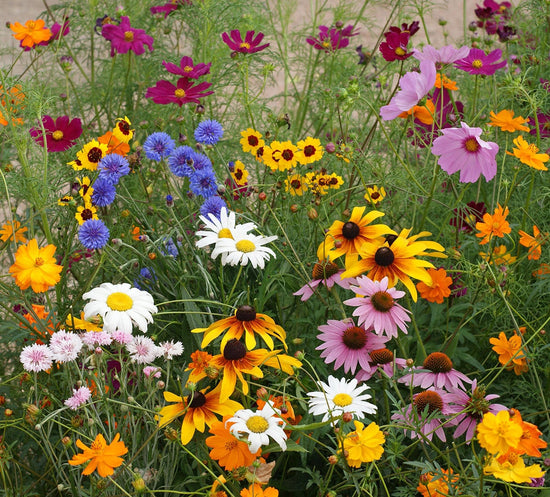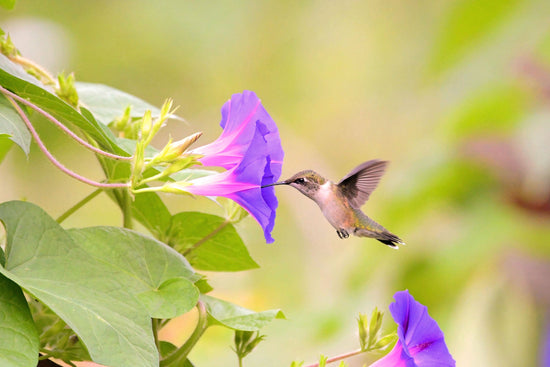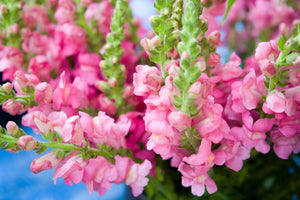How to Grow Columbine Flowers for a Natural Hummingbird Garden
Columbine flowers bloom from early spring into the middle of summer in most growing zones. Their nectar is an important food source for hummingbirds and butterflies at this time of year. If you want to create a hummingbird garden, be sure to include Columbine.

There's much to like about Columbine plants, from the various colors and petal patterns to the unique foliage. These easy-to-grow flowers are sometimes referred to as “granny’s bonnet.”
Blue Columbine flowers have always been synonymous with the mountains of Colorado as its state flower. But these beautiful spring wildflowers come in a variety of colors and have naturalized all over the United States.
With over 70 species of columbines (Aquilegia), this adaptable wildflower is sure to find a home in your garden.
How to Grow Columbine from Seed
Starting Columbine plants from seed is fairly easy at any time of year. The best time to plant seeds will depend on your growing zone. You can sow seeds outdoors in the fall or mid-winter. Winter sowing is ideal for cold locations. In warm and cool climates, you can start seeds indoors and plant outdoors when conditions are favorable.
Tips for fail-proof Columbine seed germination
Gently press seeds into the soil and don’t cover them.
Columbine seeds need light to germinate.
Seeds will germinate in 21 to 28 days.
Cold stratification is not necessary, but it can improve germination rates.
Winter sowing is a great way to start these wildflower seeds.
If starting Columbine seeds indoors, harden off seedlings and transplant outdoors when they are several inches tall and have at least two sets of true leaves.
Not all Columbine flowers look the same. The blue Columbine, the state flower of Colorado, looks different from varieties such as McKana’s Giants.
Columbine flowers can hang down or be straight. But all columbine leaves have the same pattern.
McKana’s Giants have large, three-inch flowers with three-inch blooms and grow to three feet tall. Hummingbirds are attracted to the red flowers and the sweet nectar.
How to Grow Columbine Plants
Columbine flowers are a beautiful and useful flower to add to any garden. The flower shape and nectar attract butterflies and hummingbirds.
Columbines are hardy enough to return year after year and will self-seed. They can also cross-pollinate, which results in new colors and shapes.
Plant Columbine in a shady wildflower or cottage garden. It will bloom with your other spring flowers, like sweet peas. Columbines are a natural choice for growing under the dappled shade of large trees and can even be grown in containers.
Columbine plants can come back from frigid winters and can be grown in zones 3 - 8.
Columbine plants will grow as a mounding clump of foliage. The flowers will emerge from stems that reach above the foliage. The beautiful leaves add interest and texture around trees and throughout a flower garden.

Sun
An excellent shade flower, Columbine prefers to stay cool and appreciates afternoon shade. It can also grow in full sun, but when temperatures get too hot, the plant will go dormant.
Soil
Plant Columbine in soil with good drainage and a slightly acidic pH. If you have heavy clay soil, amend it with organic matter before planting.
Water
Moderate amounts of water are best to keep your Columbine plants thriving. Plants in their first year of growth will need more water. Even though the plants can be drought tolerant, dry spells will result in fewer flowers.
Fertilizing
Use the right kind of fertilizer for growth. Columbine doesn’t need high amounts of nitrogen, but phosphorus is helpful for root growth.

Deadheading and Pruning
As with most flowers, deadheading spent columbine flowers will encourage the growth of more blooms. Once the flowering season ends, you can cut back the stalks and leave the foliage. It will die back in winter and regrow in spring.
Columbine is a perennial, but it will need to be reseeded after about four years. You can let it drop seeds where it is growing and new plants will emerge.
Columbine pests and diseases
Slugs, snails, and leaf miners are some of the pests to watch for on columbine plants. Mature plants are generally deer—and rabbit-resistant, but young seedlings are tempting.
Leaf miners won’t destroy the plant but will leave white trails through the leaves.
Use baits and other methods to protect Columbine plants from slugs and snails.
Use effective watering methods to mitigate diseases caused by too much moisture, such as root rot, powdery mildew, and other fungi.

Harvesting Columbine Flowers
Columbine flowers bloom in late spring to early summer in most locations. They are a delight in the garden and can also be enjoyed indoors as cut flowers. Once cut, they have a vase life of 5 to 7 days.
For use in indoor arrangements, cut Columbine flowers when they are still in early bloom. A stem with about half of the blooms open will result in a longer vase life than one with all the blooms open. The flowers will continue to open up after they are cut.
Once the flowers have bloomed, you can enjoy the beautiful foliage until it dies in winter.
Columbine FAQs
Can Columbine flowers be grown in pots?
Are Columbines hard to grow from seed?
Columbine flowers are easy to grow from seed if you follow these simple tips. Gently press them into the soil. Columbine seeds need light to germinate. Be patient. They take 3 to 4 weeks to sprout. The easiest way to sow Columbine flower seeds is to winter sow.
What month do you plant Columbine seeds?
You can start Columbine seeds indoors at any time of year. This will allow you to transplant them outdoors when conditions are favorable.
Do Columbine seeds need cold stratification?
Cold stratification can improve germination rates, but it is not required.
Do Columbines like sun or shade?
Columbine flowers like cool temperatures and some shade. They can grow in full sun, but they will stop blooming if temperatures are too hot.
Are Columbine flowers deer resistant?
They are considered deer-resistant; however, deer will eat anything available when offered.

Don’t miss out on growing columbine flowers in your garden. This easy-to-grow wildflower is beautiful and beneficial for supporting the habitat of butterflies and hummingbirds.
Plant Columbine seeds today and enjoy the benefits for years to come.






Leave a comment